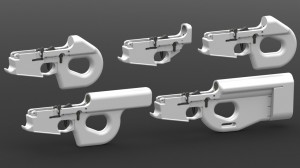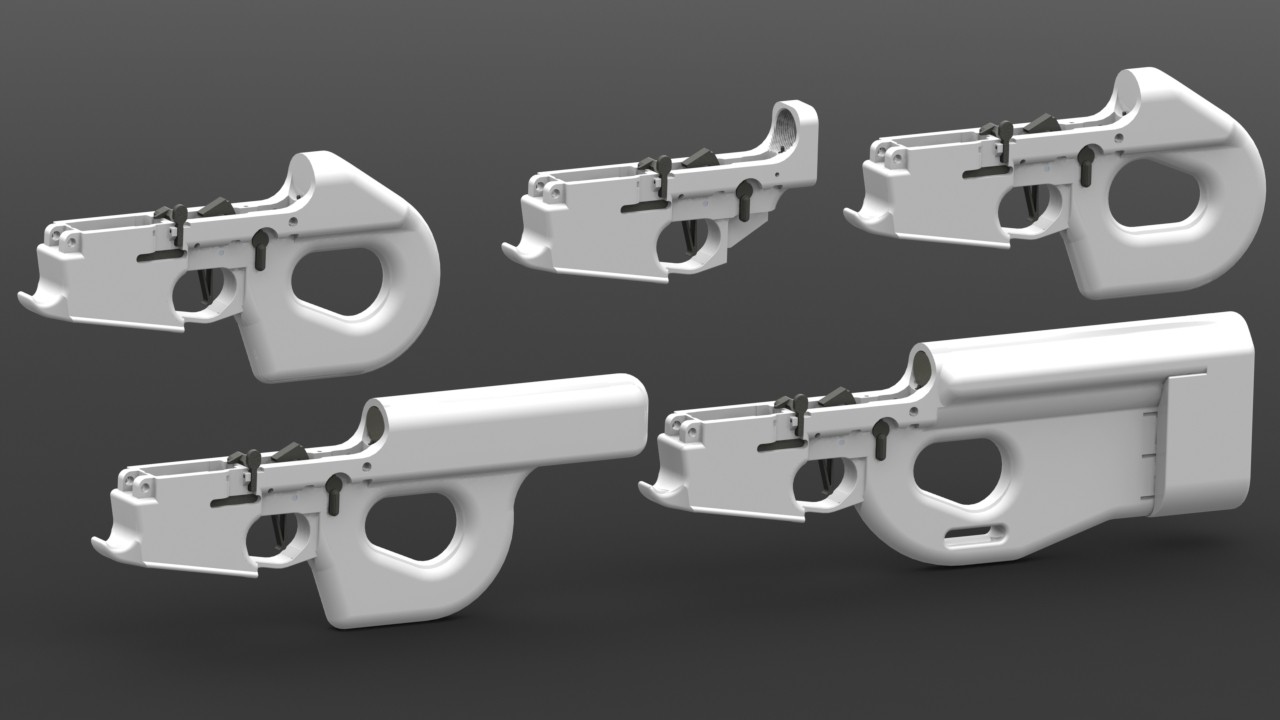“Reservations about rapid technological change are widely shared regardless of political party or philosophy. In America, the tensions between approval of science and worry about the rapid changes it can bring bubbles up in special ways when moral or cultural choices seem to be involved.” This quote by author Jonathan D. Moreno from his book The Body Politic describes perfectly the landscape of the current controversy surrounding the notorious 3D printed guns.[1] With the ability to now “print” off the frame of semiautomatic firearms, technological innovation is changing in a way that is unregulated by the federal government. Printable guns rattle the structure of our current legal system because this new technology challenges standing social norms and universal mores. These “guns,” created by the intangible and conceptual means of computer code manifested through melted plastic, have resulted in a legal grey area.

© Wikimedia Commons
This new technology poses a threat to national security and, by its very existence, further deregulates the movement of weapons between hands. Cody R. Wilson, representative of Defense Distributed (DD), believes regulation of printable guns violates the second amendment. According to DD’s website, the company has dedicated itself “to defend[ing] the civil liberty of popular access to arms as guaranteed by the US Constitution and affirmed by the US Supreme Court, through facilitating global access to, and the collaborative production of, information and knowledge related to 3D printing of arms and to publish and distribute, at no cost to the public, such information and knowledge in promotion of the public interest.”[2]
Wilson initially began distributing computer aided design (CAD) files for lower receivers for AR-15 style weapons on Thingiverse, a website that distributes files for printing 3D objects by a community of users. After a year, however, Thingiverse removed Wilson’s files when they did not comply with the website’s terms and conditions. After being removed from Thingiverse, Wilson began using his own website to distribute the files. Wilson was then required to obtain a Federal Firearms License for the location of the 3D printer that would be printing the lower receivers. The true controversy here is the creation of the lower receiver. Virtually anyone can purchase the separate parts for a gun frame online. But the lower receiver, the part that holds the gun together, allows the gun to operate, and is only obtainable through registration with ATF. But with the way 3D printing operates, Wilson escaped prosecution due to a lack of restrictions on individuals manufacturing firearms for personal use.[3]
DD has a manifesto listed on its website dating back to the 1600s. It originates from an argument made by Mr. John Milton against England’s parliament passing a piece of legislation called the Licensing Order of 1643. The Licensing Order put strict censorship rules on books before they were published. From Milton’s perspective, the censorship of printing is a persecution of a civilian’s rights. Milton’s Areopagitica, also referred to as, “For the Liberty of Unlicenc’d Printing,” lists the reasons why Milton believed books should be freely published and only questioned by law after print rather than being prohibited from print completely. The creators of DD argue this same point and see a censorship of printing weapons to be as unjust as censoring the publication of a book in print [4]. But should the same logic apply with the changing tides of technology?
The technology of 3D printing, also known as stereolithography, was first created by Charles Hull in 1984. The printer works much like an inkjet desktop printer in that it lays the desired material down in layers, just as the inkjet does with ink. The layering of materials, organized and based on the design specified in a software such as CAD, is done on a moveable platform. As this layering completes, the result is a three dimensional object. Since its creation, the technology behind 3D printing has been responsible for multiple innovations such as body organs, cars, and prosthetics.[5] Now, Wilson uses this same technology to create lower receivers and magazines. A magazine, designed more so to make a point, is simply a CAD file for a plastic box and a spring. To censor the printing of such an object seems inconceivable, but its intended use forces one to think otherwise. Although DD isn’t the first company to create such components and distribute CAD files for arms frames, they have become the test subject for how society and, most importantly, the government, will react.[6]
The federal government has three avenues to pursue when addressing the issue. First, the government can force-fit current existing laws around this specific case. Second, the government can proceed by rewriting current laws to address this new technological issue. Third, the government can choose to write a completely new law that aims to address this current issue as well as set precedence for similar issues to arrive in the future.
Thus far, the government has already attempted the paths of the first and second options. On May 8, 2013, the Enforcement Division of the US Department of State’s (Dos) Office of Defense Trade Control Compliance delivered Wilson a letter of notification that the CAD files on his website were illegal. Under the requirements and restrictions of the Arms Export Compliance Act (AECA) and the International Traffic in Arms Regulations (ITAR), Wilson’s files were removed from DD’s website.[7] There are several points of this government action that are noteworthy. It is peculiar that the issue became a concern of the DoS rather than the Department of Defense. However, because the DoS is responsible for the interpretation and application of the AECA and ITAR, it would seem that the DoS was the only avenue the government could take in shutting down the website, thus concluding that the only laws under which DD could be stopped were the AECA and ITAR.[8]
The AECA, enacted in 1976, regulates the exportation of “defense articles” and is implemented through the ITAR. It is not necessarily inherent that the activities of DD are to be considered “exportation,” and other areas of the application of the AECA are questionable. The defense articles regulated by the AECA are listed on the US Munitions List (USML). The letter sent to DD from the DoS lists all of the files that violate the USML and includes popular weapons files such as the “Defense Distributed Liberator pistol” and “.22 electric.”[9] The list is broken down into two categories that specify the defense articles as defined by the AECA. The first category refers to all components, parts, accessories, and attachments for firearms of automatic and semiautomatic weapons up to .50 caliber. The second category covers all defense articles for weapons beyond .50 caliber. At first glance it would seem that the AECA would not apply to the CAD files distributed by DD. The first and second categories are defined by tangible, physical defense articles, while the CAD files are merely code stored as data in software. So how was it that the government was able to use the AECA to shut down the distribution of DD? Because the AECA is implemented through the ITAR, the ITAR offers specifics on how the AECA applies to the case of DD.
The ITAR has a very intentionally broad application, used to regulate any piece of technology that could potentially be used for military purposes. In the past, ITAR has historically been applied to regulate space technology. The policy put stringent regulations on the spacecraft industry as a result of paranoia during the Cold War. The result was a big debate by both non-profit and for-profit companies in the industry about the broad use of the USML and its effects on the progress of innovation and research in space technology. It wasn’t until 1984 that President Ronald Reagan relaxed the control of the DoS on space technology through ITAR. This relaxation was a derivation of Reagan’s decision to allow communication satellites to launch on foreign countries’ rockets. However, since that time, spacecraft has stayed on the USML and has continued to stagnate the space industry’s growth.[10] The application of this law on technology sets a sort of precedent for the case of DD.
In addition to its prior application regulating space technology because of the technology’s potential for military use, other parts of the ITAR directly relate to the activities of DD. The definitions of such terms “defense articles,” “export” and “technical data,” are telling as to why the federal government made the decision to use the AECA when intervening in DD. The term “Defense articles” refers to any “technical data” identified on the USML. “Technical data” is understood as any information required for the design, development, production, manufacture, assembly, operation, repair, testing, maintenance, or modification of defense articles. Therefore, the CAD files containing the data to 3D print gun parts can be regarded as “technical data” based on the definitions of both terms. “Export” is defined as “sending or taking a defense article out of the US in any manner (other than mere travel outside of the US by a person whose personal knowledge includes ‘technical data’).”[11] Due to the nature of the Internet, it would seem as though DD is violating this understanding of exportation under the ITAR. Although DD is outside the parameters of ITAR, and precedence is set by the regulation of spacecraft technology, there is still room to question whether regulating CAD files through a Traffic of Arms Regulation is really the most effective course of action.
This may be why the government has proceeded down a different course. The US government passed “The Undetectable Firearms Act of 1988.” The act was a response to Libyan dictator Muammar Qaddafi’s purchase of hundreds of plastic handguns that would be undetected by airport security measures. The act has been renewed twice in the past two decades and has received bipartisan support.[12] But the rise in Wilson’s popularity has prompted the action of several congressmen.
On May 8, 2013, Representative Edward J. Markey of Massachusetts wrote a letter to the Acting Director of The Bureau of Alcohol, Tobacco, Firearms and Explosives (ATF) demanding action addressing the “rapid advances in firearm technology.” Markey claims Wilson and the developers at DD found a loophole that made the plastic guns legal under the Undetectable Firearms Act. The firearm DD constructed included small metal components. These components ensured the plastic gun complied with the Undetectable Firearms Act. At the end of his letter, Representative Markey calls for action: “ Given the rapid development we have witnessed in this industry, please describe how ATF intends to approach the advent of 3D printed guns and the availability of blueprints for creating functioning firearms capable of evading detection.”[13]
Two congressmen from New York have since responded. Representative Steve Israel and Senator Charles Schumer have moved to update the Undetectable Firearms Act in order to better address the rising concern over DD’s latest technological advances. The updated law, to be called “Undetectable Firearms Modernization Act,” currently has seven cosponsors and was referred to the Subcommittee on Crime, Terrorism, Homeland Security and Investigation in April 2013. The drafted bill calls for several actions. It moves to reauthorize the ban on undetectable firearms, a law that expires on December 9, 2013 [14]. Based on findings by the Federal Bureau of Investigation cited in the drafted bill, approximately 69 percent of total murders in the US are committed with the use of a firearm. This statistic, coupled with the undetectable nature of the plastic guns and their easy access through 3D printing technology, led Mr. Israel to update the act by including regulation on both undetectable receivers and magazines.
The drafted bill includes several modifications to the Undetectable Firearms Act and moves to ban all firearm components that cannot be detected by metal detectors. The draft also specifies that weapons which cannot be detected “…after the removal of grips, stocks, and magazines…” should be banned. This specification targets DD almost directly. The language of this law closes the loophole Wilson and his cofounders had been utilizing. Looking at the bill as a whole, it is obvious that the edits made by Representative Israel are in direct response to the actions taken by DD. But is this enough? Does editing a bill do enough to address the rising concern over the effect 3D printing guns could have on society? Although the application of the AECA and drafting the Undetectable Firearms Modernization Act are actions being taken to ban the CAD files and prohibit the 3D printing of weapons, both options lack in an important quality that all just laws should consider.
Congress must write a new legislation that does not punish users of DD’s weapon files that aim to use the information for legitimate purposes. The current direction the government is taking may very well result in a complete ban of 3D printed guns whereas the aim should be to somehow regulate what the guns are and who owns them. In tune with the DD’s manifesto and Milton’s argument that censorship of printing violates civilian rights, another legislative avenue must be pursued.[15] The creation of this new technology means that the conventional understanding and definition of “arms” has changed. A new piece of legislation will explore a more comprehensive and conceptual understanding of what arms are and under what circumstances they must be regulated as we move further into the 21st century. Because such emphasis is placed on the lack of a serial number on a 3D printed lower receiver and the undetectable quality of the plastic components, one option may be to allow the distribution of some 3D gun component files but require the purchase of a metal receiver with a legal serial number. Therefore, the 3D printed technology of arms is limited, rather than banned completely. Even so, there are aspects of this case study that are unprecedented, and the reaction of judicial and legislative branches is unpredictable. The issue of 3D printed guns will have to travel through the legislative process, and then perhaps there will be an opportunity to assess its justice.
References
[1]Moreno, J. D. (2011). Introduction. The body politic: the battle over science in America (p. 16). New York: Bellevue Literary Press.
[2] http://defdist.org/about
[3]http://www.youtube.com/watch?v=DconsfGsXyA
[4] http://www.dartmouth.edu/~milton
[5]http://individual.troweprice.com/retailCommon/applications/brandjournalism/3DPrint/3D_Printing_Infographic.pdf
[6]http://www.youtube.com/watch?v=DconsfGsXyA
[7]http://www.infowars.com/breaking-3d-printable-gun-ordered-to-shut-down-by-government/
[8]Ordway, John A. “US International Traffic in Arms Regulations (ITAR).” Berliner, Corcoran and Rowe L.L.P. http://www.cistec.or.jp/english/service/report/0802ITARarticleforCISTEC.pdf
[9]http://www.youtube.com/watch?v=DconsfGsXyA
[10]Lohmeyer, Dwyer, Gettliffe, Marinan, Aliby, Weigal, Kerry Cahoy. 2012. International Astronomical Congress: The Global Impact of ITAR on the For-Profit and Non Profit Space Communities.
[11]Ordway, John A. “US International Traffic in Arms Regulations (ITAR).” Berliner, Corcoran and Rowe L.L.P.,www.cistec.or.jp/english/service/report/0802IRARarticleforCISTEC.pdf
[12]Keeping Plastic Weapons Out of Airports. (2013, Nov. – Dec.). Bloomberg BusinessWeek,10.
[13]Markey, Edwards J., Letter to Mr. B. Todd Jones, 1-2. Washington, D.C.
[14] http://www.highbeam.com/doc/1G1-350579326.html?refid=bibmehf
[15]http://www.dartmouth.edu/~milton



